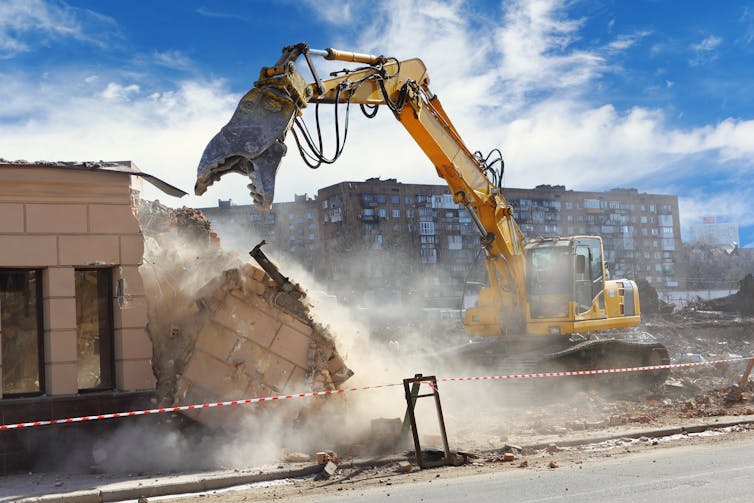Demolition work is the most dangerous job in construction, which itself is one of the industries with the highest injury rates. The tragic building collapse and loss of life at the disused Didcot A power plant in Oxfordshire is a stark reminder of just how dangerous demolition can be.
One person is dead and three are still missing after a large part of the main boiler house collapsed on February 23. While it’s far too early to know what actually caused the accident, there are a number of reasons why buildings can collapse unexpectedly during – or just prior to – demolition.
Firstly, and most significantly, contractors may not fully appreciate the structural principles of the building they are dealing with. For example, if a key component – which could be an obvious large girder or something as small as a nut on a particular threaded steel rod – is removed the remaining building could become less stable and must be checked by a competent structural engineer.
Failing to understand the consequences of altering or removing key parts of a structure was tragically demonstrated when a building in Stanley Road, Liverpool collapsed in 2000, killing one person. A steel beam had been bent back to allow access for a skip lorry and steel wall ties had been removed. Workers on the site weren’t aware that alterations over time meant these walls had become more structurally important.
Problems of structural stability are further compounded by recent trends in environmental sustainability and the emergence of the “circular economy”, where components and contents of buildings are recovered for resale, reuse or recycling. For example, when a power plant is decommissioned recovery of machinery and equipment is to be expected. Precious metals can be sold on, brick and timber can be reused, and even the concrete can be crushed and recycled.

This presents significant hazards as workers are required to work in the building to “deconstruct” the various elements, rather than use a long-reach demolition rig from a safe distance. It is not unusual to essentially cut a hole or doorway in the wall to allow large machinery to be easily moved in and out. An additional consequence of this method is it allows wind to flow through the building, which can “load” the walls beyond their tolerance levels.
If the cumulative effects of removing fixed machinery that could very well be attached to structural elements of the building, removing parts of walls, and other parts of the building are not considered, then the consequences could be catastrophic.
Explosions are the other main risk. In Didcot’s case, one avenue for investigation might be accidental detonation. After all, three of Didcot’s disused cooling towers were demolished with explosives in July 2014. However, cooling towers are relatively simple structures which lend themselves to explosive demolition rather than excavators or dismantling piece-by-piece. The building that collapsed was probably planned to be demolished by one of these more conventional means. However, such specialist explosive work is invariably undertaken under the control of an experienced explosives engineer, so the more obvious source of an explosion might come from what fuelled the building – gas or coal.
Gas may build up in the plant itself, leak from pipes over time, or could be present in a “live” pipe that was thought to be “dead” or isolated. In these cases, a spark or source of ignition could easily set off an explosion. Such explosions tend to kill indirectly, as the force causes walls to explode and the roof to fall down, crushing the workers below. This is what happened when corroded 35-year-old gas pipes caused the 2004 Stockline Plastics factory explosion in Glasgow which killed nine people.
Coal dust can also cause these sorts of explosions. In fact, most types of dust can cause an explosion if airborne and sufficiently agitated. With the right dust/air ratio, a substantial dust cloud can easily be ignited and cause an explosion equally as devastating as gas.
Early reports indicate an explosion just prior to the collapse at Didcot, though this was later denied. However, any causes identified here can only be considered as potential avenues for investigation. The UK’s Health and Safety Executive’s investigation will undoubtedly uncover the actual cause (or causes) of the collapse in due course.
Hopefully lessons can be learned for the future. But, of course, this will be of little consequence to the families of the dead and missing workers.

